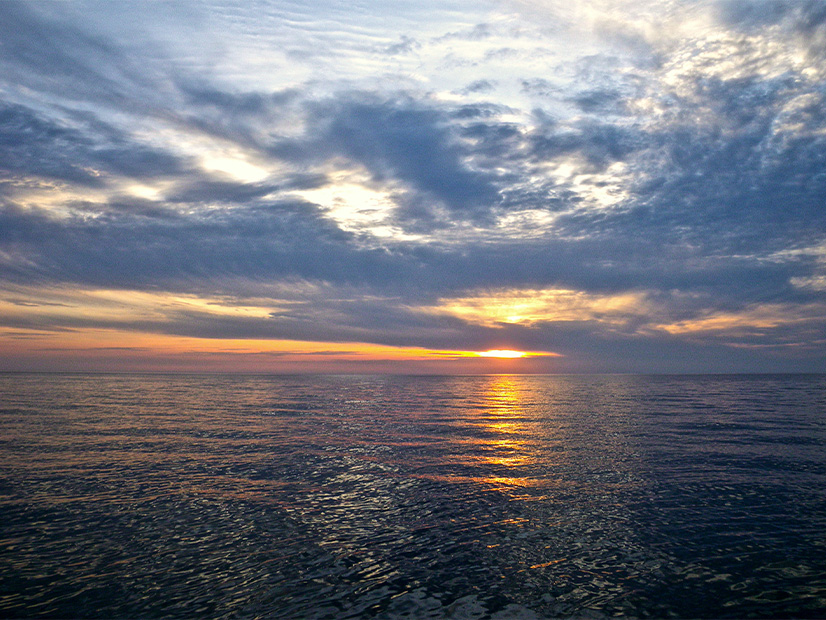
Developing wind power on the two Great Lakes bordering New York would entail a set of challenges so expensive as to be uncompetitive with other renewable energy options, a new report concludes.
The New York State Energy Research and Development Authority last week submitted its Great Lakes Wind Energy Feasibility Study and supporting material to the state Public Service Commission, which in 2020 instructed NYSERDA to undertake the study.
NYSERDA recommended shelving the lake wind concept for at least the near term.
The study indicates that modeling shows potential for as much as 2 GW of nameplate wind power capacity in Lake Erie and 18 GW in Lake Ontario.
But it also flags several sticking points:
- Lake Ontario is so deep that development there would rely on floating turbine technology, still in its infancy.
- Both lakes ice up in the winter.
- An entire onshore supporting infrastructure would need to be created, along with points of interconnection for the electricity generated.
- Unlike the extensive OSW capacity that the state is developing in the Atlantic Ocean, the Great Lakes are far removed from the densely populated New York City region, where the need for clean energy is greatest.
- The construction vessels used to erect offshore wind farms will not fit in the locks that lead to the Great Lakes.
A white paper submitted with the study concludes that wind farms in the two lakes would be substantially more expensive for ratepayers to support than other projects under Tier 1 of the state’s Clean Energy Standard, such as terrestrial wind and solar. That does not include construction of ports, ships and points of interconnection, which would be additional costs for ratepayers to bear.
NYSERDA began conducting the study in February 2021. Some support was offered for the idea of Great Lakes wind during the public input process, but extensive concern was raised about its impact on wildlife and on views from the shore.
Preserving the viewshed would be a significant limiting factor; siting turbines at least 12 miles offshore would limit the potential hosting capacity in Lake Erie to just 200 MW, for example.
There’s also widespread sediment contamination in the Great Lakes, a legacy of the industrial history of the cities along its shores. That contamination is not well-mapped, NYSERDA notes, nor is it known what effect construction would have on the contaminants.
“After completing the feasibility study and considering these various dimensions collectively, NYSERDA recommends that now is not the right time to prioritize Great Lakes wind projects in Lake Erie or Lake Ontario,” the white paper indicates.
But it adds: “Taking no action now does not mean there may not be an opportunity to advance Great Lakes Wind at some point in the future. The resource may become a feasible contributor to New York State’s goals in the future as the state advances toward its mid-century goals.”
An organization advocating for offshore wind buildout said the study made a convincing case.
“While New York needs a serious buildout of renewable energy sources and there is documented potential for wind resources in the Great Lakes, it’s clear from the report that the focus should remain on solar, land-based wind and offshore wind power in the Atlantic. Right now, these are the more critical, substantial and cost-effective opportunities,” New York Offshore Wind Alliance Director Fred Zalcman told NetZero Insider.
There is extensive interest in offshore wind as an emissions-free source of electricity, with the Biden Administration setting a goal of 30 GW installed capacity by 2030.
Just one facility is online in the U.S., producing up to 30 MW off the Rhode Island coast, but a few others are under construction and many more are in some stage of development.
Only one is in freshwater — the 20.7 MW Icebreaker project near Cleveland in Lake Erie — and it is still in development, more than 13 years after it was proposed.
NYSERDA said the Ohio project could eventually help inform New York’s decision-making process on wind turbines in its Great Lakes waters.
A previous proposal to build a freshwater wind farm in New York proved highly contentious. After nearly four years in the review process, developers in early 2019 withdrew their plans for a 108 MW project near Watertown, in the northeast corner of Lake Ontario.


